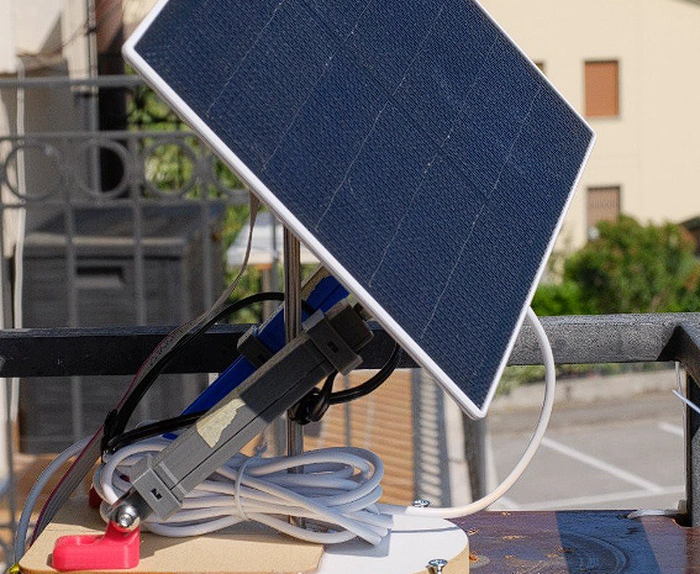In the realm of renewable energy, a groundbreaking device known as Mysoltrk is a fantastic project powered by Arduino designed to track the sun’s position, optimizing solar panel performance and maximizing energy production. The tracker is robust, cost-effective, and sturdy enough to withstand outdoor conditions, making it an ideal solution for those seeking to harness the power of the sun.
Mysoltrk stands out from other solar trackers due to its unique design and functionality. It does not rely on Wi-Fi or GPS, a strategic decision made to keep costs low. Instead, it employs low-cost linear actuators, 3D printed with a mechanism to lock the shaft. These actuators are powered by an N20 6 volt 30 RPM geared motor, ensuring efficient and reliable operation.
The tracker’s ability to detect the sun’s position is facilitated by four photo-resistors housed inside a printed viewfinder. This ingenious system enables the solar array to be steered towards the sun, ensuring equal sensor values and optimal energy capture.
Mysoltrk solar panel Sun tracker
Mysoltrk operates using a set of two straightforward, yet sturdy actuators, each one constructed around a 6V 30RPM geared DC motor. This motor facilitates the rotation of a threaded rod, which in turn shifts an M3 nut forwards or backwards. By positioning these components on a shared plane and linking them at their peak with a ball joint, a well-structured triangular system is formed that capably adjusts the panel along three axes.
At the heart of Mysoltrk is an Arduino Nano, chosen for its low power consumption, affordability, and ease of modification. A L298N h-bridge drives the motors, while a shunt replaces limit switches to further reduce costs. The device also incorporates a voltage divider to read the power coming off the panel and prevent circuit browning out when moving the actuators.
Mysoltrk’s design is not just about functionality, but also about practicality. The device is compact, making it suitable for balconies or small gardens. It is 3D printed, waterproof, and requires minimal hardware, keeping costs low. The tracker is self-tracking, eliminating the need for GPS or WiFi.
The device is capable of charging smartphones, power banks, or external cameras in small spaces, thanks to its high energy production. The solar panel is designed with three support points for sturdiness and wind resistance. It can be moved to capture the sun during peak energy times, with two additional support points realized with actuators. These can be placed on the base or hooked to the pole that supports the panel.
2023 Hackaday Prize Green Hacks challenge
Mysoltrk’s innovative design and functionality earned it a place as a finalist in the 2023 Hackaday Prize Green Hacks challenge. This recognition underscores the potential of this device to revolutionize the way we harness solar energy, making renewable energy more accessible and efficient.
Celebrating a decade of technological creativity and innovation, the Hackaday Prize transcends beyond a competition. For the last ten years, it has ignited the minds of the open source hardware community and stimulated the electronics industry, pushing boundaries and prompting creative solutions to dire global issues. By merging the inventiveness of this global community of engineers, designers, scientists, and hackers with the urgency of these inherent challenges, the Hackaday Prize has been at the forefront of generating designs that truly make a difference.
Marking this year as its 10-year milestone, the Hackaday Prize evolves by instigating an intriguing set of challenges. However, these aren’t entirely new grounds for its tenacious community. Instead, these tasks are a call back to some of the most resonating themes that the open source community has successfully addressed over the last decade.
Through the years, the Hackaday Prize challenges have evolved as our world changes. Tackling everything from climate change and sustainability to technological applications that benefit vulnerable populations, the competition has been a beacon for disruptive, transformative technology. The global open-source community has consistently risen to these challenges, demonstrating not only their technical prowess but also their commitment to affecting meaningful change.
This a landmark year, is not only recognizing the community’s past triumphs but also encouraging them to build upon their previous work. The challenges provide an avenue for the participants to not only showcase their skills but to probe deeper, using the benefit of hindsight and pooled knowledge, to come up with pioneering solutions that can impact the world.
More than just a contest rewarding innovation and creativity, the Hackaday Prize is a celebration of an open-source community dedicated to the betterment of our world. This 10-year milestone embraces the tenacity, the ingenuity, and the spirit of this collective of engineers, designers, scientists, and hackers from around the globe. Together, they set their sights on the challenges that lay ahead, ready to champion the powerful themes of their past and eager to create the technologies of the future. The success and growth of the community over the last decade show no sign of abating, and the community and Hackaday eagerly look forward to the phenomenal accomplishments the next ten years will bring.
Source: Hackaday
Filed Under: Gadgets News
Latest Aboutworldnews Deals
Disclosure: Some of our articles include affiliate links. If you buy something through one of these links, Aboutworldnews may earn an affiliate commission. Learn about our Disclosure Policy.







